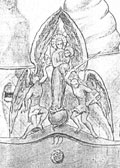|
The
Relationship of Gaudí
and Carles Mani
The sculptor Carles Mani i Roig (1866-1911) is a typical
example of an artist belonging to the end of nineteenth century, who led
a miserable life, immersed into the utmost solemn poverty. The artist
profession was regarded as a contemptible bohemia and to try to get in
the society of that time was an almost heroic task. I remember that the
painter from Valencia Víctor Moya Calvo (1890-1972) told that when
he was a student in the Academy of San Carlos in Valencia and being then
fifteenth years old, he was asked to paint the window card of a grocer's
shop, a work that was rewarded with twenty-five pesetas. Well, his class
mates did not talk to him during fifteen days, enraged and full of envy
for the ephemeral success of their friend.
Carles Mani was born in Móra d'Ebre (Ribera d'Ebre)
and he moved to Barcelona very young and matriculated in the Fine Arts
School, in the Lonja. He did not get any job in Barcelona moving with
his poverty, first to Madrid, where he lived for two years an where he
prepared a plaster model of the group "The degenerated" with
human micro-cephalic forms, having enormous hands in a prostration attitude,
which perhaps reflected the decayed soul condition of Mani. Of this model,
he did several versions in different sizes, and showed it in the Exhibition
that took place in the Fine Arts Palace of Barcelona in 1907 and it is
here when Gaudí intervened.
Alter living in Madrid, Mani moved to Paris where he lived
thanks to the charity of Santiago Rusiñol, always disposed to go
protect the artists of his country, and when he came back to Barcelona,
he frequented the Sagrada Familia and worked in the model maker's workshop
directed by Llorenç Matamala. He did a plaster Immaculate that
did not please father Gil Parés and the magnificient Christ from
the Casa Batlló Oratory, in 1906, an image having a posture that
differs from the generality of the Holy Christ sculptures but that was
suggested by Gaudí, by considering the usual way of crucifixion
used by the Romans.
Poor Mani dragged himself along the Temple works and Joan
Matamala remembered him lying in the ground with a row of ants promenading
over his body.
In the1907 exhibition he presented "The degenerated"
life-sized, although he said that the definitive form in stone would match
the height of the great pyramid, and the responsible of the mounting placed
the sculpture in a corner beside the staircase. Mani had a terrible deception
and went to the Sagrada Familia crying to tell Gaudí his trauma.
Gaudí listened him patiently and he went afterwards to the Fine
Arts Palace and talked with Carles Pirozinni i Martí, the exhibition
secretary, convincing him to change the place of "The Degenerated".
The critics were merciless with Carles Mani. Actually, if this work must
be judged the Casa Museo Gaudí in the Park Güell must be visited,
where there is a small sized plaster model, but it is imposing because
of its dramatic feeling.
 |
|
Till the death of Mani in 1911 Gaudí went
on offering him several commissions in the Temple, and especially
the Virgin with the Archangels Michael and Raphael, a gilt bronze
group being four metres and a half high, to be placed crowning the
Pedrera façade, in the Paseo de Gracia-Provença chamfer.
Carles Mani could finish the life-size plaster model
in the first floor of la Pedrera, by then at works. The sculpture
did not please the Milàs and it did not go beyond the model
condition. After Mani's death in 1911 it was completely impossible
to think in carrying out Gaudí's project with the sculpture
of Mani. Many years later Gaudí asserted that had he known
that the Virgin image would have not be placed, he would not have
charged of the project and directing of the works. Of the gaudinian
idea only remain the angel's salute sculptured in the top part of
the façade: "Ave gratia plena Dominus tecum" (Hail
full of grace the Lord is with thee). The missing word "Maria"
ought precisely to be the sculpture by Mani.
|
The artistic sensibility of Gaudí enabled him to
understand the talent, rather daring and terrible, of Mani. And the kind-hearted
architect made the sculptor to survive with the commissions in the Sagrada
Familia, casa Batlló and la Pedrera. After the death of Carles
Mani, Gaudí went on helping his widow, Antonia Bonay, and his nephew
Pau Badia Ripio (1887-1976), a sculptor who worked in the Sagrada Familia
workshop and who, many years later, painted the portrait of Gaudí
in the Colonia Güell and a new wood carved version of the Casa Batlló
Christ, now in the Architecture Museum in the Royal Gaudí Chair.
The difference between the two sculptures is that Batlló Christ
is the Expiation one, whereas the one by Pau Riba is the Dead Christ.
Joan Bassegoda i Nonell (24th of February, 2000)
|